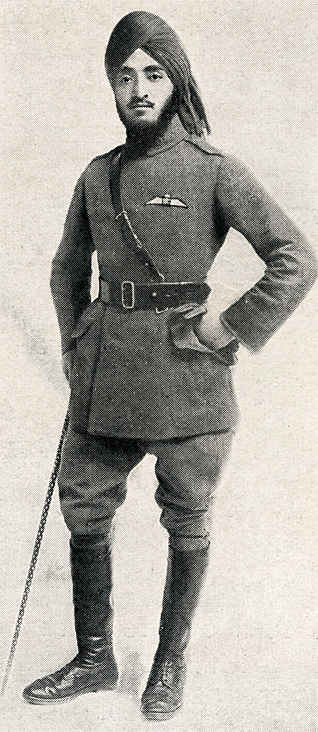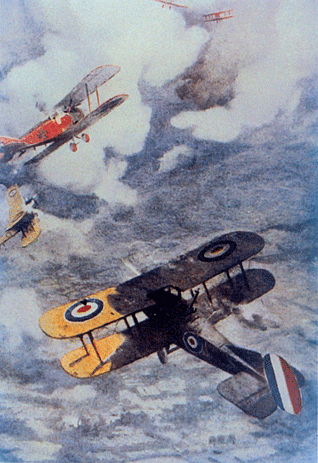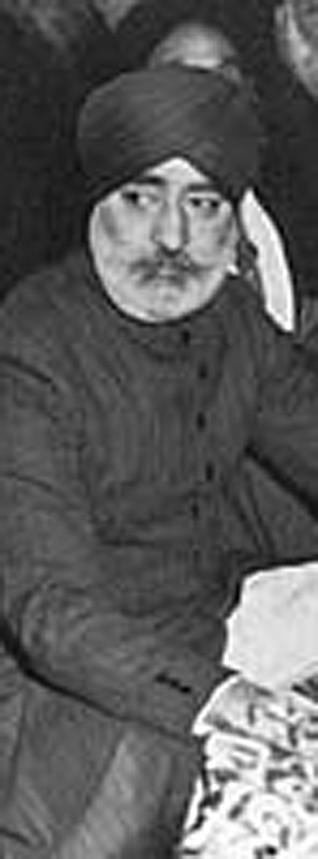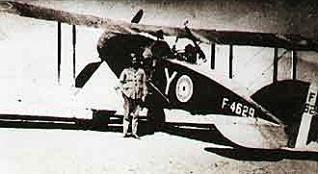
Above: Hardit Singh. Below: A British Bristol Fighter FB2 and a German Albatros D.III in combat during WWI. Hardit Singh flew this type of Bristol Fighter for the Royal Air Force. First from bottom: Lt. Hardit Singh, standing next to his aircraft.


Ambassador
Hardit
Singh

History
Flying Ace & Pioneer
by PUSHPINDAR SINGH
History records that man's first heavier-than-air flight took place on 17 December, 1903 at Kitty Hawk in North Carolina, U.S.A. The man was Wilbur Wright, in a machine that had two wings attached with criss-crossed wires, a tail, an engine driving a propeller, but little else other than a great dream. The contraption flew several feet above the ground, for a few hundred yards.
Just over six decades later, men have walked on the Moon, and man-made machines have gone beyond the solar system.
Still, in the few years just after 1903, the Americans continued to be less enthused about powered flight than were the Europeans. By 1909, many pioneers had built and flown their own aeroplanes. They were mostly French, followed by a few Germans, Dutch and Englishmen.
The first Indian, or indeed Asian, to procure aeroplanes was the then-young Maharaja of Patiala, Bhupinder Singh, who was following aviation developments with keen interest. The Maharaja sent his chief engineer to Europe for an on-the-spot study and then ordered three aeroplanes, including a Bleriot monoplane and Farman biplanes. These aeroplanes arrived in the Punjab in December 1910.
The Sikhs have been pioneers in flying ever since - be it in military or civil aviation, as pilots or engineers - virtually from this dawn of flight. Even now, as we forge ahead in the new millennium, Sikhs remain at the forefront of aviation activities ... in India, they continue to be in the vanguard of the Indian Air Force, Naval Air Arm, Army Aviation Corps, and the air wings of the Coast Guard and Border Security Force.
Many are with international airlines, as Boeing 747 "Jumbo" commanders, flying distant intercontinental routes from Chicago to Bombay, or as captains of Airbus A-320s, operating in South-East Asia. Quite a number are with the Royal Malaysian and Singapore Air Forces, others in East Africa.
However, the very first Indian to fly, join the Royal Flying Corps, get his wings, go into aerial combat on the Western Front, shoot down German fighters and himself be seriously wounded in the air, was an outstanding personality: Sardar Hardit Singh Malik. His life and times were so extraordinary and his achievements so varied, that it is most meaningful to dwell upon his pioneering career.
Born on 23 November, 1892 in a distinguished Sikh family of Rawalpindi in the Punjab (pre-partition India), Hardit Singh was educated at an English Public School (Eastborne College), from where he went to Balliol College at Oxford. Graduating with honours, his scholastic achievements were matched by his sports prowess, getting his blues in cricket and golf.
When the Great War broke out in 1914, he was at his second year at Oxford and practically all his British colleagues volunteered to join the fighting services.
Following a personal interview with General Henderson, who was commanding the Royal Flying Corps ("RFC"), Hardit Singh joined the RFC as a cadet at Aldershot early in 1917, the first Sikh and Indian in any flying service in the world. A specially-designed flying helmet was worn by Hardit Singh over his turban.
Hardit Singh was selected for fighters and went "solo" in a Caudron after just two-and-a-half hours instruction. He was posted to Filton, near Bristol, flying the Avro 504, the BE 2C, the Sopwith Pup, the Nieuport and finally the Sopwith Camel, the most advanced fighter at this time.
At Filton, RFC pilots were taught combat tactics, including the famous Immelmann Turn. Hardit Singh got his wings in under a month.
Posted to No.28 Squadron and equipped with the Camel, the formation soon flew out to St. Omer in France, then to an airfield in Flanders near the village of Droglandt.
Here, Lt. Hardit Singh Malik first met the new Commanding Officer, the legendary Major William G. Barkar, who had come from Canada as a cavalryman in 1915, joined the RFC in 1916, and flown two-seaters and fighters, becoming an ace many times over. Barkar was considered the greatest all-round pilot of World War One, and he personally initiated Hardit Singh into the art and science of aerial combat, leading him into the first actions, including those against the legendary "Red Baron", Manfred von Richthofen's Staffel.
In one major dogfight, with over a hundred British and German fighters scrapping over the battle lines, Hardit Singh shot down his first German Fokkerand.
He went on to notch another eight aerial victories in the weeks ahead, before he himself was wounded in action, but survived in amazing circumstances. After months in hospital, Hardit Singh rejoined the service, now renamed as the Royal Air Force, flying the Bristol Fighter, probably the best fighter of the war, with No.141 Squadron at Biggin Hill, a specialist unit created for defending London from raiding Zeppelins and Botha bombers.
As described then,"One of the first to be posted to the new squadron was Lieutenant Hardit Singh Malik, a Sikh from Rawalpindi .. a keen cricketer and golfer, Malik was one of the most popular officers at Biggin Hill. He staunchly refused to part with his turban and somehow managed to fit over it an outsized flying helmet, earning the affectionate nickname of "Flying Hobgoblin" from the ground crews. Besides Malik the Sikh, the original fighter pilots of Biggin Hill included men from Australia, Canada, New Zealand, Rhodesia, Argentina, as well as the United Kingdom".
After the armistice, Hardit Singh was posted to another Brisfit Squadron, No.11, at Nivelles near Brussels, before he finally returned home after the War, a hero in his own right.
Hardit Singh Malik was to later join the prestigious Indian Civil Service. As a postscript, this remarkable man's chequered career included assignments as Trade Commissioner in London, Hamburg, Washington and Ottawa.
He became Prime Minister of Patiala State and then, Indian High Commissioner to Canada; still later, he was named Ambassador to France.
After retirement in 1956, he returned to his first love, golf, becoming India's finest player ever, even with two German bullets still embedded in his leg.
Sardar Hardit Singh lived till he was 91, passing away in November 1985.
Sardar Pushpindar Singh is the author of The History of the Indian Air Force. He is also the Executive Editor of Nishaan Magazine.
[Photo on top of this page: Courtesy, Sardar Bhupinder (Peter) Singh Bance, author of The Sikhs in Britain.]
Conversation about this article
1: Tejwant (U.S.A.), October 18, 2007, 11:04 AM.
I'm proud to say that S. Hardit Singh Malik was my granddad - Dr. Balwant Singh Malik's cousin. Co-incidentally, Hardit Singh Malik was also Prof. Puran Singh's cousin from his bhua's side.
2: Chintan Singh (San Jose, California, U.S.A.), October 18, 2007, 11:12 AM.
Excellent biography of S. Hardit Singh Malik. With so many achievements, I am surprised he is hardly known. There should be a book on Sikh contributions to worldwide aviation.
3: Bhupinder Singh (Canada), October 18, 2007, 5:10 PM.
It is indeed a proud moment to learn that (a) S. Hardit Singh Malik was a WW1 hero, and (b) that he was the first Sikh and Indian to become an air-pilot. At times, he has been mentioned in the media as an Ambassador and High Commissioner, but never was any credit given to him for his being an air pioneer ... and a world-class sportsman too! Unfortunately, even the Indian Air Force has failed to give him due credit in any of their history, literature, celebrations or official functions. As an ex-Air Force officer, I can say that I had never learnt of this hero as a flying ace, although it was common knowledge of his having performed well in the civil service. Sad, that we are told so much about politicians but never about heroes such as him.
4: Ari Singh (Sofia, Bulgaria), October 20, 2007, 3:10 PM.
As a former aeronautical technician (trained in Kerala), I had heard of Sardar Hardit Singh but never knew that he was such a hero! It's time somebody compiled an encyclopedia of famous Sikhs. Great article.
5: Sarvjit Singh (U.S.A.), November 20, 2007, 10:54 AM.
I remember as a young kid hearing about some elderly Sikh man who was the first Sikh and Indian Pilot. In fact, I might even have seen/met him by chance. Can someone please confirm if he lived in Vasant Vihar, New Delhi? So that my memories can be cherished once again.
6: Bhandari Pawittar Singh (Canada), July 04, 2008, 11:18 AM.
Sardar Malik was the first High Commissioner for India in Canada. I tried with the Indian and Canadian authorities to get his pictures for my book on Indo-Canadians. You are very resourceful. May I use these pictures, with credits? [Editor: Yes, you may.]
7: Vernon Lynn Stephens (Louisville, United States), December 20, 2008, 8:47 PM.
I worked with Dr. Balwant Singh Malik at a correctional-psychiatry hospital from about 1982-1985. He certainly was, in the face of considerable wickedness and dishonesty, about the MOST-BRAVE MOST-MILITARY-BEARING guy I ever knew. For 'shenanigans', he faced considerable black-balling duress - but went-out as bravely in this abusive ambiance as he came in. Thus, I am not surprised about the pedigree/genotype of courage-under-fire in Dr. Malik's lineage - for such a visage 'soldierly' (his particular background was Indian-naval.) Indeed, at about that time as Dr. Malik's helling, I caught hell also - and would always return to the stiff-upper-lip-do-what's-right stance of Dr. Malik. His example taught me that even when one must face the Judas' bullet - it is ever/always best to behave ethically - and NOT TO WHIMPER. So, thus I think the Maliks and Sikhdom are a BOON BLESSING CREDIT KUDO to the human race (otherwise Homo sapiens in-sapiens whining.) DO give best high regards to Dr. Balwant Malik - to all the Maliks so military - and to your NO-FEAR-faith. [Vernon Lynn Stephens, MSSW, D.S.M. IV-TR # 296.44]
8: P.S. Bhandari (St. Laurent, Quebec, Canada), December 21, 2008, 10:27 AM.
It is indeed an excellent and well researched article about S. Hardit Singh Malik.
9: Chris Flack (Derby, United Kingdom), February 18, 2010, 10:57 AM.
As a serving member of the Royal Air Force, I am proud to say that more information about these pioneer heroes can be found at the UK's premier National Sikh Museum in Derby, United Kingdom. [www.nationalsikhmuseum.com] - Please feel free to venture along and see all the artefacts on display.


